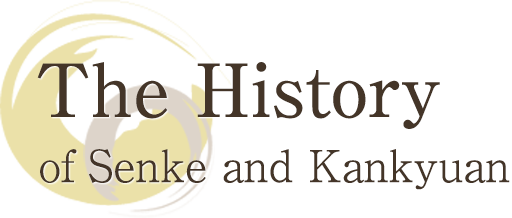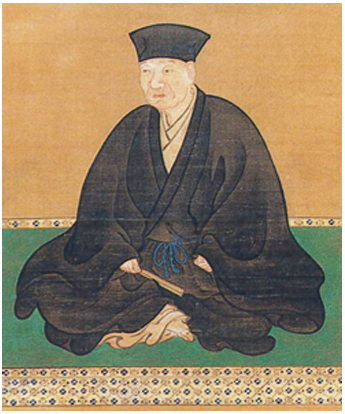
Sen Rikyu’s grandson, Genpaku Sotan, had four sons. The oldest son, Kan’o Sosetsu left the house, making his second son, Ichio Soshu, third son, Koshin Sosa, and fourth son, Senso Soshitsu the first successors of Sen Rikyu to continue the tradition of tea by each establishing the tea ceremony schools, Kankyuan, Fushinan, and Konnichian respectively. …Read more
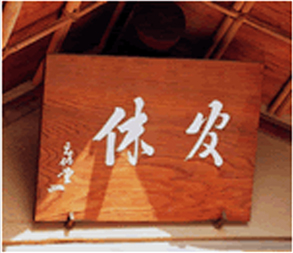
“Kankyu”, written by Genpaku Sotan, is hung over the “Kankyuan” tea house
It is said that when Ichio was building the teahouse with his father, Sotan gave it the name “Kankyuan”.
The meaning of the name is not clarified, but in 1774, on the 100th year anniversary of Ichio’s death, Shingansojo, the 390th high priest of Daitoku-ji (Temple) wrote a poem interpreted as saying, “Surely he retired (as tea ceremony instructor) to devote himself to tea.”
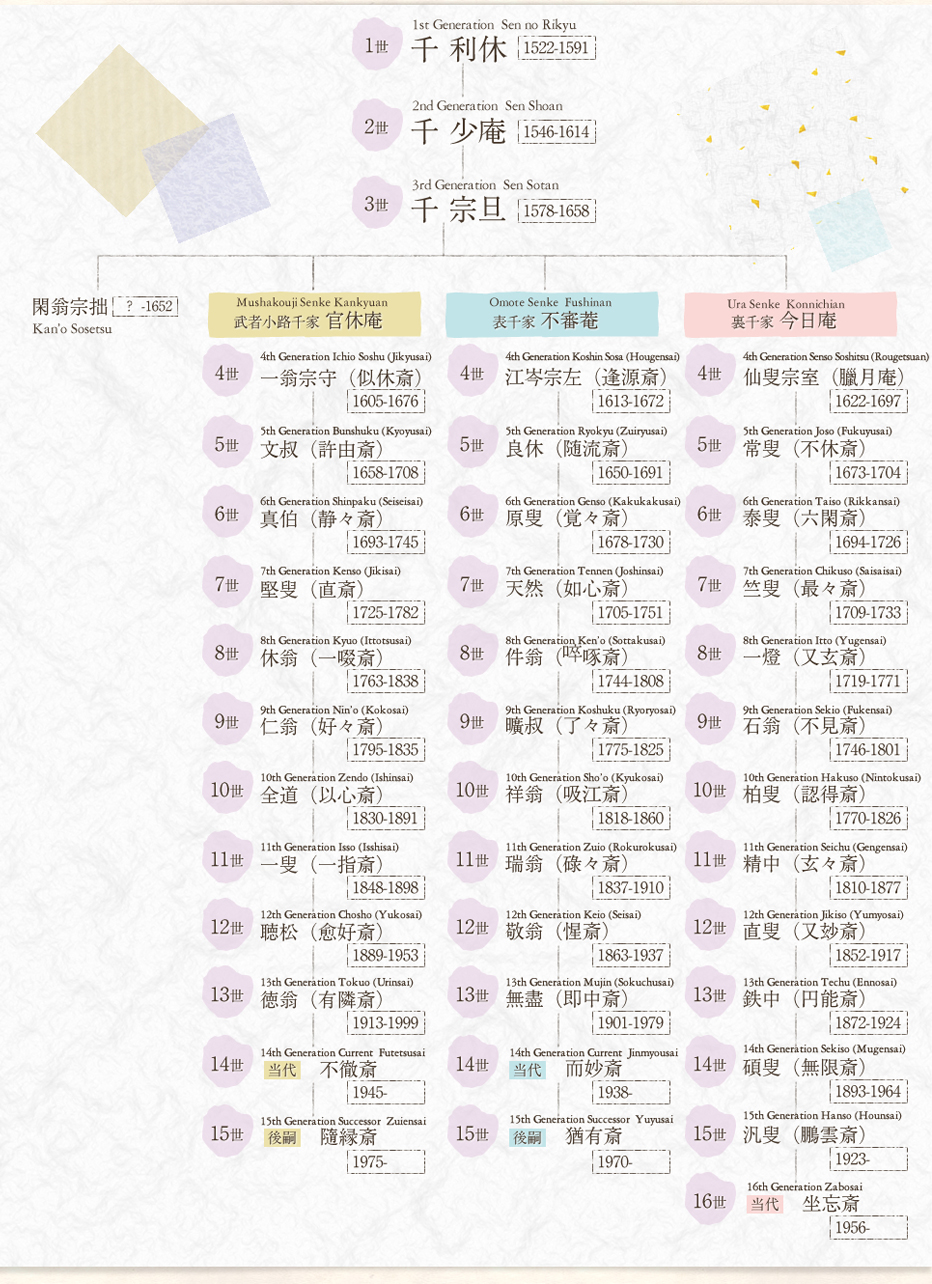
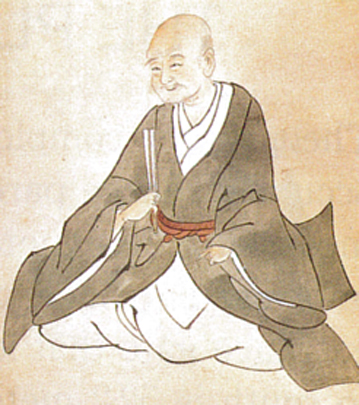
Jikyusai Ichio
The family name, “Soshu”, was given to Ichio by his Zen teacher, Gyokushu Soban, the 185th high priest of Daitoku-ji (Temple), and it is the custom for the head of the family of each successive generation to use this name professionally. Since Ichio, the family of Sen Rikyu has tirelessly continued its spirit and blood lineage for four hundred years, reaching Futetsusai, the current head master.At the same time, the name “So’oku” is inherited by successors and the name “Soan” is taken after retirement.

-
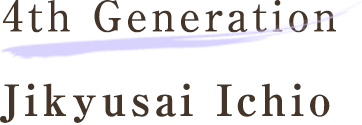
Ichio left the Senke household according to the wishes of his father, Sotan, and returned to establish Mushakouji Senke at the encouragement of his brothers. There are various historical rumors about the origin of Kankyuan, which is at the center of Mushakouji Senke, but many think it represents leaving the world of bureaucracy for a simple life of retreat, which refers to Ichio’s retirement as tea instructorto the Matsudaira clan.
The name Jikyusai brings to mind the image of Ichio who longed for and emulated Rikyu.
A comparatively plain person; Bunshuku is seen as having an extremely keen sense regarding tea utensils, having written many expert opinion pieces on Yorakuin Konoe’s tea scoop chest and Rikyu’s tea scoop, flower vase, tea utensils, etc.

He was an artist who could write Chinese style characters. At that time a new writing style called mincho, which was respected as a refined skill, was coming over from China. Shinpaku illustrated vertical zen scrolls with this elegant script. He made a great number of scrolls with beautiful calligraphy, and they continue to out rank all scrolls made by generations since. Starting in the mid-Edo era, the times began to call for a general change and development within society; Shinpaku took this responsibility upon himself. He is regarded as an outstanding talent that developed the modern tea ceremony and died at the age of 53.
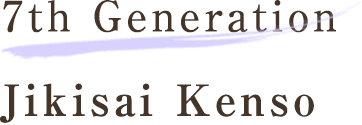
Called the revival of Kankyuan. This era called for big changes within the tea ceremony to accommodate more members, tea tools used since Rikyu’s time were set as the core of the tradition and the head master system was organized.
When Jikisai was 48 years old (1772), Kankyuan was destroyed by fire. He rebuilt it two years later on the 100th anniversary of Ichio’s death. Jikisai also built Kodoan, measuring 15 tatami. Until then, apart from Zangetsutei (tea room) of Omote Senke, the largest room size was over 4 and a half tatami or at the most 8 tatami, in the time of Rikyu’s tea lineage, making it an unprecedented move to widen a room to 15 tatami.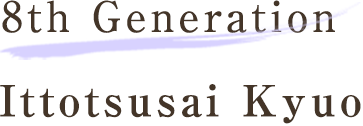
He did not stand out living under the shadow of his father, Jikisai. One way or another he still became head of the family known for unique activities and lived a relatively long life within the successor generations. He had many hand-made instruments and produced new shelf designs such as eboshidana, jizaidana, etc. He also reconstructed Ippoan which had burned in the Tenmei Fire, renaming it “Hanpoan”. A structure measuring 4 and a half tatami, with a masudoko (an alcove in a tea room) cut into the tatami, nakabashira (a pole extending from a corner of the hearth) and daimegiri (a hearth cut into three-quarters of the tatami mat).

The third son of Ura Senke’s Sekio Soshitsu, he became the adopted son of Ittotsusai, but died before his father at the age of 41. However he made many tea cups, and is especially known for his ceramic style pottery over earthenware.

The younger brother of Kyukosai, the 10th generation of Omote Senke, he is the child of Kokosai, the 7th generation of the Hisada family.
As a child his eyes were damaged from illness and he lost his eyesight. Kokosai’s wife, Soei acted as the head of the school with the help of Sousen Kizu and adopted Isshisai, born to Kyukosai of Omote Senke, to continue the Mushakouji Senke line.
It was a difficult period within the chaos of the Meiji Restoration following the destruction of the Kaei era fires. In 1881 Isshisai rebuilt tearooms, gardens, and during the second half of the Meiji era he created the foundation of the tea ceremony revival. The present day Sodo (Totoken) was the preferred teahouse of this time.

Yukosai is the second son of Genjosai (youngest son of Kyukosai), the Hisada family’s 10th generation. He was adopted by Isshisai, but was cared for by Omote Senke after his father, Isshisai’s death in 1898. After reaching adulthood, he returned to revive the suspended Mushakouji Senke.
He reconstructed Kankyuan in 1926 and restored Kodoan in 1940 on the 350th anniversary of Sen Rikyu’s death. He revived Jikisai’s 15 tatami reception hall in the east teahouse garden, for the attendance of many guests. Yukosai was very active in the study of the tea ceremony and his ideas were widely known.
He entered Kankyuan as the predecessor’s son-in-law in 1941. In 1964 he opened the country’s first tea ceremony vocational school, “Sen Sado Bunka Gakuin”. In the fall of 1983, after his 70th birthday, he took the name “Tokuo” and retiring in 1989, he changed it to “Soan”. He maintained a resolute life of isolation and was a valuable existence within the easy times of the modern tea ceremony world. He died in 1999.

Born to Urinsai Tokuo Soshu and a cooking researcher Sumiko Sen in 1974, he was given the successor name “Soshitsu” and in 1989 he was given the Buddhist name “Futetsusai” by Fukutomi Settei, former Kyoto Murasakinou Daitoku-ji chief priest. In December that year, the previous generation’s Urinsai became ill, moving Futetsusai to take the name “Soshu” and he is still active today.
In 1993 he built the present day tea house of Kifuken in the sukiya style and the black lacquered tea room, Gyobunkaku in 2005.
He was born the oldest son of Futetsusai Soshu. In April of 2003, he was given the successor name “So’oku”. In June of the same year, he was given the Buddhist name “Zuiensai” by Fukutomi Settei, former Kyoto Murasakinou Daitoku-ji chief priest.
In 2007, he took a liking to “Tenyujoku” tea tables and created a new kind of tea ceremony at a table to match the modern lifestyle.
In 2008 he went to America as a cultural exchange agent of the Agency for Cultural Affairs and worked in New York for one year to spread tea ceremony culture.
Having a thorough knowledge of tea ceremony utensils, Japanese art history, and antiquities, as well as contemporary art, he actively interacts with present day modern artists and participates in a wide range of activities.
In January 2013 he was awarded the Kyoto Prefecture Cultural Award, Encouragement Prize.




















